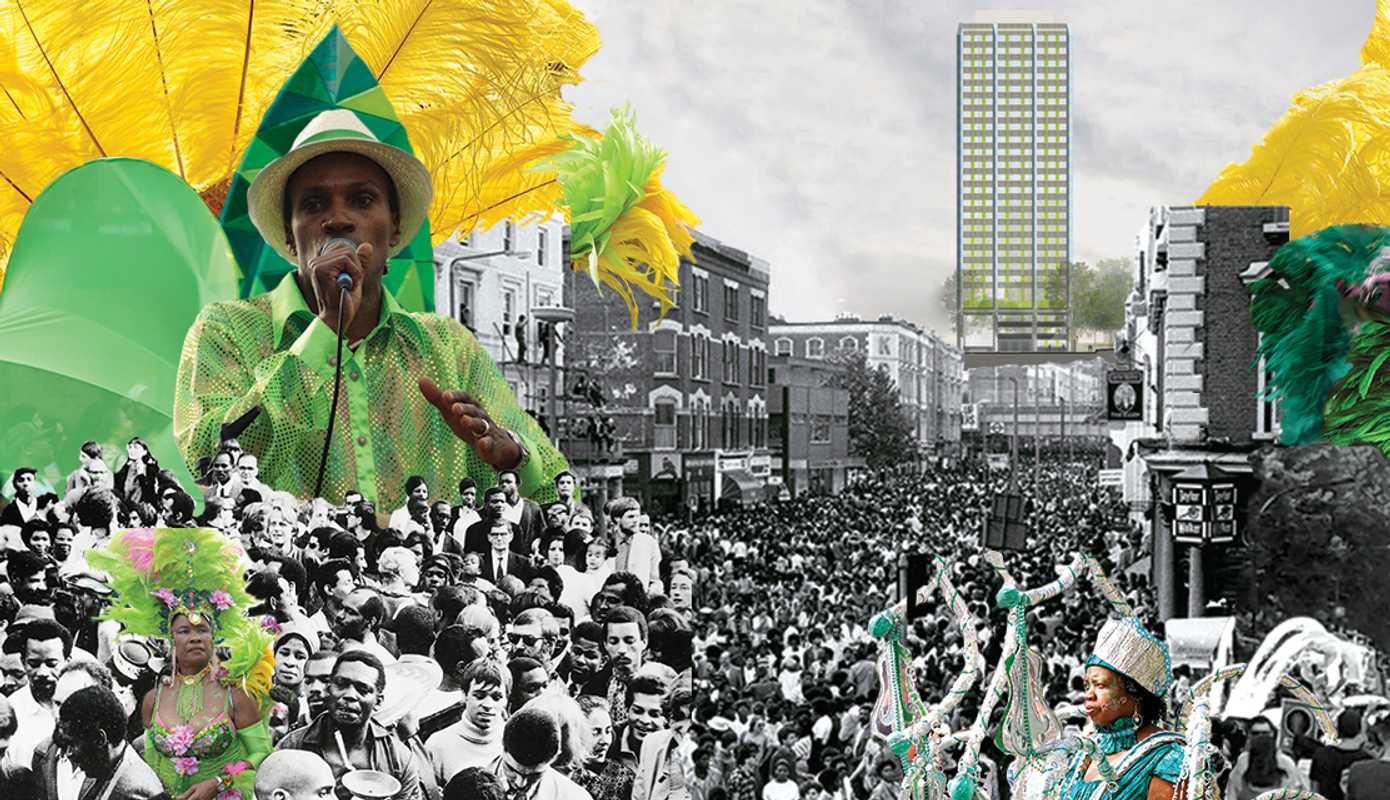The fire at Grenfell Tower in West London brought about an immediate and overwhelming spirit of selflessness, as people rallied to aid survivors and help search for missing persons. The inadequate response of the state, whose willingness to prioritize profits over people, particularly working class and PoC communities, mobilised many to get involved.
Weeks after the tragic event, refuge centres had closed, donations had mysteriously disappeared into storage, and survivors were living in hotels and substandard or temporary accommodation far away from the support networks that were crucial to their healing in the aftermath of the fire.
The events of the fire brought to light the ongoing and nefarious efforts of developers, fueled by corporate greed and encouraged by the prospects of making big money, to clear out and “revitalise” areas where communities of colour have historically lived. Not too far away from Grenfell, up in Acklam Village at the top of Portobello Road, communities of colour have been mobilising since the seventies to stave off and confront the efforts of developers who want to profit off of the “vibrancy” of an area that many have called home for decades.
Skin Deep contributor Christian Adofo spoke to Niles Asheber and Emzee Haywood, both of whom are heavily involved in community activism in the Ladbroke Grove and North Kensington area through their work with Westway 23 and One Voice Community Collective. The former is a direct action group that was created in response to the Westway Trust’s controversial “Destination Westway” project, which sought to implement a strategy that aimed to bring retail and development to the area without the consultation of local community members, while the latter’s mission is to advance the socio-economic interests of people of African & African Caribbean heritage in the UK and beyond, through the promotion of community goals and aspirations.
*
Christian Adofo: Can you speak to the history of community organising in this area, and the origins of your particular organisations?
Niles Asheber: We are in Bay 56 in Acklam Village on Acklam Road, a 23-acre plot of land underneath the Westway A14 Motorway that was left to the local community by Transport for London in 1971. The construction of the motorway started in 1964 and ended in 1970. During that period, people protested against the disruption that this motorway was going to cause by cutting right through the community. The events culminated with members of the community actually marching on the motorway in an attempt to disrupt traffic.By 1971, a piece of land was given to the local community as compensation for the destruction caused by the motorway. There was a large population of African-Caribbeans living in the area at that time (alongside small pockets of Irish and Polish communities), the majority of whom took part in these actions. Today there are less of us here, but the history that we created on this land is one of the major reasons why this place is known all over the world. We have made contributions to the area but have been denied the economic, social and spiritual benefits of those contributions; we have been excluded from and disenfranchised by the developmental projects that are now taking place. If you think about the vibrant community that existed here and the culture that it brought to the area, you realise that this place should have been comparable to somewhere like Harlem, where people come to see the culture and history.
CA: This area has a real cultural significance too, even for people who don’t live here.
NA: Yes. But now, if you walk around the area, what do you see?
CA: It’s completely decimated…
NA: What adds insult to injury is that you have establishments like Boom Burger and the Rum Kitchen, which stands where Mangrove (a famous Caribbean restaurant owned by community activist Frank Crichlow) once stood, selling pseudo-Caribbean food. All of these restaurants are being marketed as part of the culture of the area; people think “I’ll come to Ladbroke Grove and experience the culture,” but it’s an inauthentic appropriation of the culture in such a way that appeals to, and is comfortable for, the Chelsea set. You can’t find anything authentic on these 23 acres anymore.
CA: How have you worked to reclaim this as a base?
NA: In 2014, I was tipped off about Westway Trust’s (a social enterprise and charity created in response to the building of Westway flyover) Annual General Meeting, so I went down there and I saw a group of people in corporate clothes talking about how wonderful the area and culture were. They had this plan called “Destination Westway” that was going to revitalise the area and generate all these “wonderful things” for the community. Yet the community members were not the ones who were talking, it was the people in corporate clothing.
They had cardboard cutouts of children smiling and steel pans. I actually stood up in the meeting and pointed that out. I said that what I am seeing right now doesn’t bode well for this community because what I am seeing is a corporate face talking about how wonderful everything is going to be, with the only representation for the community being the cardboard cutouts behind you.
It’s now 2017, and the development company has compromised in a way that makes it feel like the community does have some influence. We now have some people that sit on the Board of Trustees. There are three black women on the board, which is split 50/50 between the community and the corporation.
Emzee Haywood: The hard thing now is that they have a lot of property people on the board and they keep employing more property people, even though it’s a charity. They keep a lot of the community trustees away from making those core decisions.
CA: What measures have you put in place to ensure that Acklam Village is a safe space for those affected by the fire?
NA: The whole plan up until now has been to create a safe space for the community, away from the war going on outside. The trauma of the fire, and the trauma of whatever people were dealing with before, has meant that we are faced with a lot of concerns about the future of this community. Of course, there is also an incredible amount of love and unity, and people are coming together to do the work of rebuilding. The other side of that is that people are not really agreeing with each other and are arguing over which solutions to implement. But I always say that that has to do with the trauma, and the unreasonable expectation that people who are living in a war zone, where people have been killed, will be able to cope with the reality of the situation without adequate support. They are still coming to terms with what’s happened, and at the same time have to contend with the negligence of the government, the borough, and KCTMO (Kensington and Chelsea Tenant Management Organisation), as well as the charities not caring.
Neglect caused Grenfell to happen, as did the culture of regeneration, redevelopment and corporate greed, which has started to affect the work that the housing trusts and charities do. These organizations were originally set up to serve and be resources for the community but they have since come under corporate control. The Council is on the side of these developers and corporations and pushes their agenda, while willfully ignoring the red flags that are raised by these projects – they push these projects through without paying due care and attention.
CA: You had a press conference a few weeks ago in which you brought up many of these issues. What are your long-term plans to make sure that the stories of those affected by the fire are accurately represented, especially when the mainstream coverage has been so diluted?
EH: We have made sure that we are the ones controlling the narrative. You’ve got people from Harrow Club, someone from Westway Sports, another person from Adventure Centre (a local indoor playground), another person from the Flyover and someone from the Tower on the panel. We’re making sure to include a range of people, even some of the young ones who are volunteering here. These are the people that know who got caught up in the fire, who survived, and who didn’t. It’s about getting an array of people up on that panel and saying that we’re just going to talk about donations this week, and that every week after that will be about a specific topic. The bottom line is that if they (the press) don’t report it correctly, then they are not invited back again.
CA: You’ve talked about the communal aspects of the space you’ve created; can you tell us about how you’ve kept that up, and how it compares to when the initiative first started and there was a flurry of volunteers?
NA: We haven’t needed to make a call for so many volunteers now because the phase of lifting boxes and managing donations is not as intense. I think what happened in the initial stages was phenomenal. I don’t think you can keep that up as everyone would burn out and crash. Survivors are still coming here every day, and they aren’t coming in here saying that we don’t need to do this anymore. At the same time, we’ve been hearing that the aid and relief are winding down, which is how the system tries to shut down efforts like this.
CA: But they are not here to see what is going on nor are they here to talk to the local community are they?
EH: Exactly. Who gets to decide when things have ended and what are they basing that decision on? People have lost their homes, their family members, and neighbours. They are still being affected by those losses.
NA: We will be dealing with the repercussions of this for decades. It’s just not going to end next week or the week after. For us, it’s a continual process of healing and trying to empower the community to move into a new phase that is born out of the ashes of Grenfell, like a phoenix rising from the ashes. There are those of us who know what happened and are committed to keeping that alive. We’re energized and working to keep the truth on the table and to make sure that we get justice. Justice not just for the crime that was committed, but justice in the sense that we want to change the rhythm of the way things happen, because as the rhythm changes, so does the dance. It’s not about the one thing, it’s about our whole existence here and about creating a new paradigm for the future.
CA: Activism wise, it feels like young people are coming here and learning how to be mobilised in a way that is not reactive or impulsive.
NA: The crime rate actually went down because people have been focused on helping. I think that the fire has made more people think more critically about what it is going on. The other day, some of the young people came up to the town hall meeting all balaclava-ed up. They came dressed in the clothes that people expected them to be in, and some people definitely felt threatened by that. But when they spoke and what they had to say to the press was really eloquent and on point, people began to understand that their intentions were peaceful. They told them that it was a peaceful movement. What they were saying is, “We are getting organised, you’re not getting away with this and we are not going to kick off, because we know what’s going on.” That’s change.
CA: Given the history of this place and everything that we talked about in terms of the work of Westway 23, the corporatization of culture and events like Carnival, and the renewed sense of community that has emerged in that aftermath of Grenfell, what are your hopes for the community?
NA: My hope is that we maintain the peace, unity, and love that is needed to create that new paradigm and bring that into being. We want to be a place where people from the community can come and deal with each other. It’s not about ego. It’s not about narcissism. It’s about a genuine intent on the part of those gathered to create a better environment for ourselves and the next generations, so we can use this as a platform from which to speak the truth. We can be a global satellite for the truth, especially in relation to what has just happened. The whole world is watching what is going on here.In a few days, the whole world is going to come down for Carnival. They are going to march past and see that building, which is a constant reminder and physical manifestation of the neglect that has gone on for years. You can’t walk past Grenfell and not feel anything. The question is: how are we going to pay tribute to those that are no longer with us?
There are plans to hold a minute of silence on both days of Carnival. It’s not going to be an easy one to pull off – we are going to need five minutes on either end to get people prepared for the minute of silence. I also think that the Carnival themes are going to have a large effect on the visual framework through which people understand what happened. If we really want it to work, then everybody has to get on board. This is an opportunity for everyone in the country to get behind the ongoing relief efforts and to pay their respects on a national level for what happened.
For more information on how you can help the community of Ladbroke Grove, who are supporting those most affected by the Grenfell Tower fire by making this year’s Carnival a bit different, click here.




